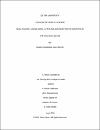Oral Cancer: Knowledge, Attitude and Practice of Dentists in The State of Qatar
| Advisor | Nur, Ula Mohammad |
| Advisor | AL Darwish, Mohammad |
| Author | Jboor, Diana Hamadallah |
| Available date | 2018-12-13T05:56:01Z |
| Publication Date | 2018 |
| Abstract | Background: Oral cancer is a silent invasive disease with poor prognosis in its late stage. In Qatar, head and neck cancers accounted for 4% of overall malignant cancers. More than 60% of these cases were diagnosed in late stages. It is mainly associated with behavioral risk factors, mainly tobacco and alcohol use. The oral cavity is an easily accessible site for examination. Dentists have a prime role in early detection and diagnosis of oral cancer. Number of oral cancer diagnosed annually is increasing in Qatar, due to the rapid increase in the population and adoption of different behavior risk factors. The aim of this study is to identify the level of knowledge among dentists regarding oral cancer clinical presentation and risk factors. To explore the impact of the dentists’ demographic characteristics (scope of practice, years of experience and last time to attend a continuous professional development (CPD) course) on the level of knowledge. To explore dentists’ attitude regarding oral cancer detection and prevention. Method: This cross-sectional study used a self-administered questionnaire with 46-items. Thirty-items of the questionnaire were scored and categorized into three level of knowledge (high-Medium-low) for the risk factors and the clinical presentation of oral cancer. The study included a total of 271 dentists practicing in Primary Health Care Centers and Hamad Medical Corporation. One hundred and seventy-seven dentists responded to the survey. Results: The mean score of the clinical presentation index is 7.59 (SD=2.40) out of total score of 14. The mean score of Risk factor index is 8.96 (SD=2.31) out of total score of 16. Younger ages are more likely to have high scores more than older age participants. Dentists with less than 10 years of experience are more likely to have satisfactory level of knowledge compared to dentists with more than 15 years of experience. Specialist dentists are more likely to have satisfactory clinical knowledge about oral cancer compared to general practice dentists. Attending a continuous professional development course about oral cancer would result in satisfactory level of clinical knowledge. Conclusion: Dentists demonstrated unsatisfactory level of knowledge about the clinical feature and the risk factors about oral cancer. The patient’s visit to the dentist is an opportunity for comprehensive oral examination. Dentists are therefore expected to be knowledgeable about the risk factors and the clinical presentation of oral cancer for preliminary diagnosis and instant referral. This study identified the gaps of oral cancer knowledge among dentists and identified the need for educational interventions about oral cancer. This is essential to improve the outcome of the health system and delivery of care. |
| Language | en |
| Subject | cancer oral cavity Dentist Qatar |
| Alternative Title | سرطان الفم: معرفة واتجاهات وممارسة أطباء الأسنان في دولة قطر |
| Type | Master Thesis |
| Alternative Abstract | سرطان الفم هو مرض صامت يغزو الجسم، و يؤدي في مراحلة المتأخرة الى مآلات شفائية ضعيفة جدا. في قطر، شكلت سرطانات الرأس والرقبة 4 ٪ من إجمالي حالات السرطان الخبيثة. تم تشخيص أكثر من 60 ٪ من هذه الحالات في مراحل متأخرة. يرتبط سرطان الفم بشكل رئيسي بعوامل الخطر السلوكية ، وخاصةً استهلاك التبغ والكحول. تجويف الفم هو موقع يسهل الوصول إليه للفحص. أطباء الأسنان لديهم دور رئيسي في الكشف المبكر وتشخيص سرطان الفم. يتزايد عدد حالات سرطان الفم التي يتم تشخيصها سنويا في قطر ، وذلك بسبب الزيادة السريعة في عدد السكان وتبني سلوكيات مختلفة تعتبر من عوامل الخطر السلوكية. الهدف من هذه الدراسة هو تحديد مستوى المعرفة بين أطباء الأسنان فيما يتعلق بالاعراض السريرية وعوامل الخطر لسرطان الفم. لاستكشاف تأثير الخصائص الديموغرافية لأطباء الأسنان مثل نطاق الممارسة وسنوات الخبرة وآخر مشاركة في احدى دورات التطوير المهني المستمرعلى مستوى المعرفة. لاستكشاف موقف أطباء الأسنان فيما يتعلق بالكشف عن سرطان الفم والوقاية منه. الطريقة: استخدمت هذه الدراسة المستعرضة استبيانًا ذاتيًا يحتوي على 46 عنصرًا. تم تسجيل و تصنيف ثلاثين عنصرا من الاستبيان إلى ثلاثة مستويات من المعرفة بالاعراض السريرية وعوامل الخطر لسرطان الفم وهي )عالية - متوسطة - منخفضة(. النتائج: متوسط درجة مؤشر الاعراض السريرية هو 7.59 ( SD = 2.40 ( من مجموع النقاط 14 . المتوسط الحسابي لمؤشر عوامل الخطر هو 8.96 ( SD = 2.31 ( من مجموع النقاط 16 . من المرجح أن تحصل الفئات العمرية الأصغر على درجات أعلى من المشاركين الأكبر سنًا. أطباء الأسنان الذين لديهم خبرة أقل من 10 سنوات من المرجح أن يحصلوا على مستوى اكثرار ض اء من المعرفة مقارنة مع أطباء الأسنان الذين لديهم أكثر من 15 عامًا من الخبرة. من المرجح أن يكون لدى أطباء الأسنان المتخصصين معرفة سريرية اكثرار ض اء حول سرطان الفم مقارنة مع أطباء الأسنان الممارسين العامين. إن حضور دورات التطوير المهني المستمر حول سرطان الفم من شأنه ان يؤدي إلى مستوى مر ض من المعرفة السريرية. الاستنتاج: أظهرت الدراسة ان مستوى معرفة أطباء الأسنان حول الاعراض السريرية وعوامل الخطر المتعلقة بسرطان الفم غيرمرضي. تعتبر زيارة المريض لطبيب الأسنان فرصة لإجراء فحص شامل للفم. لذلك من المتوقع أن يكون أطباء الأسنان على دراية بعوامل الخطر والاعراض السريرية لسرطان الفم من أجل التشخيص الأولي والإحالة الفورية. حددت هذه الدراسة الثغرات في معرفة سرطان الفم بين أطباء الأسنان وحددت الحاجة إلى التدخلات التعليمية حول سرطان الفم. وهذا أمر ضروري من اجل تحسين نتائج عمل النظام الصحي وتقديم الرعاية. |
| Department | Public Health |
Files in this item
This item appears in the following Collection(s)
-
Public Health [35 items ]


